 When her 9-year old started taking karate classes, Natasha got the bug and eventually became a black belt in karate. She discovered Tai Chi and has opened her own school devoted to teaching martial arts and wellness classes.
When her 9-year old started taking karate classes, Natasha got the bug and eventually became a black belt in karate. She discovered Tai Chi and has opened her own school devoted to teaching martial arts and wellness classes.
Tell us about your background…
Sometimes our paths in life just aren’t crystal clear. I’m really amazed by those who knew early on what their career path would be. Then again, maybe we all know instinctively and if it hadn’t been for the twists and turns of life, we would arrive at our bliss earlier. Or, maybe we just needed the self-correction experience. I view myself as falling into the latter category.
I grew up in Staten Island, NY, with my parents and an older brother, and still, live here. In college, at The City College of New York, I majored in anthropology, actually, archaeology. I remember, as a young girl, trying to dig my way to China, on the other side of the planet. As fate would have it, all hopes of digging in China were dashed due to the political climate of the times. After graduation, I found a job in a museum as an assistant librarian, and, oh rapturous day, I got to go on digs and work on their archaeological collection.
Because it was a small museum, I saw the day-to-day workings of the various departments—art, science, programming for school groups—and I became fascinated with management. Greatly encouraged by my mom to go for my master’s—this was 1974, a time before so many masters were available—I decided to get my MBA (master’s in business management). At 24, I enrolled part-time at St. John’s University. I also married a classmate from college; we will celebrate our 40th anniversary this November.
I spent 10 years working in management for nonprofit organizations then, with the advent of our children (three, all in their 30s now), started teaching remedial classes part-time at St. John’s University and at Wagner College.
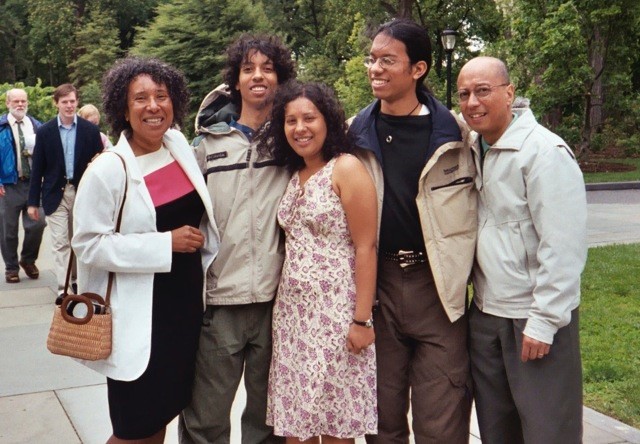
My family
When did you start thinking about a change?
When he was 9 years old, our oldest son asked to take karate classes. In the ‘70s and ‘80s, martial arts movies were becoming popular. In response to the public interest, karate and Wushu (Chinese martial arts) schools began to open. We decided to enroll our son in the karate class at the local YMCA (Staten Island), sponsored by an independent karate school. After watching a few classes, my own interest was piqued, mainly because of the character-building ideology that went along with each class.
Each class always started and ended with a short meditation. When I questioned my son’s sensei (teacher) about this practice one day, he suggested I read a book of meditations written by the founder of the school and of kata, the formalized sequence of movements: One Day – One Lifetime: An Illustrated Guide to the Spirit, Practice and Philosophy of Seido Karate Meditation by Tadashi Nakamura. This completely sold me on the art of karate; there was something so much more to karate than kids kicking, punching, and looking adorable in their karate uniforms!
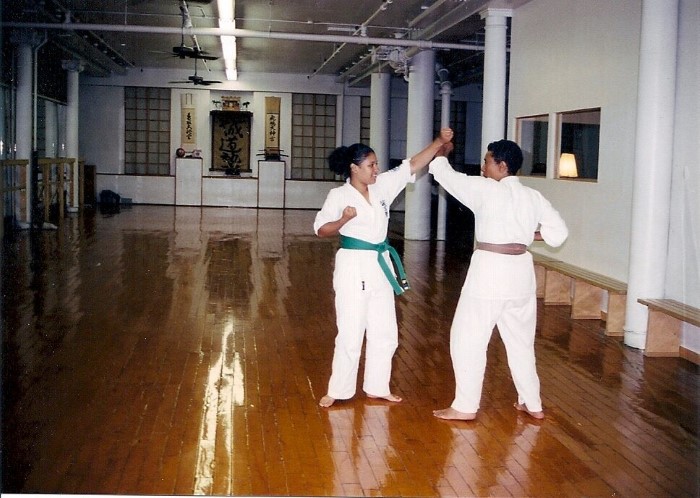
In 1994, at the age of 43, I asked if I could join the class at the Y, and was given a quizzical look by the sensei. He said yes and that there was another woman in the adult class. Little did I know he meant a 17-year-old! Fortunately for me, another mother joined. There we were, two middle-aged women practicing punching and kicking and Kiai –ing with great abandon (students yell the word “Kiai,” which means “spirit shout” in Japanese, whenever there is an explosion of power, at the end of a punch or kick). And there were the beloved katas, movements designed to practice coordination, power, and technique. When we became yellow belts, our sensei brought out our Kumite (sparring) equipment. I never envisioned sparring with another person; I was in disbelief! I was so happy with techniques and kata that I never thought about the possibility of putting them to use.
Many people think of sparring as being something more favored by men, and in those days in the dojo, karate class was mostly either for children or adult men. But my fellow female warrior and I stuck it out, and when the pool of possible fighters in the Y class became too small, and my work schedule was changing, I decided to train at the main school, World Seido Karate Organization in New York City.
When sparring, besides trying out newly acquired and cool techniques, there is a wealth of information one learns about oneself. You are put into circumstances that you would normally tend to avoid. Kumite means getting kicked or hit. Knowing that those consequences are part of sparring, one can choose to accept them and get close to the competitor or avoid them and just dance around the ring. What other things do we dance around in life rather than taking the chance of getting hit?
Another ‘gift’ of sparring is truly living in the moment. For those three minutes in the ring, fists and feet are flying, blocking and kicking. There is only one focus, the activity of the moment. There is no room for another thought to enter your mind.
Besides sparring classes, I also took kata classes and meditation classes. My introduction to meditation was in a class that took place above a pizza parlor after a noon general class on a major Manhattan cross street. To this day, I marvel at being able to dissolve into nothingness while one’s nose and stomach were being stimulated by pepperoni pizza and one’s ears tormented by police, ambulance, and fire sirens!
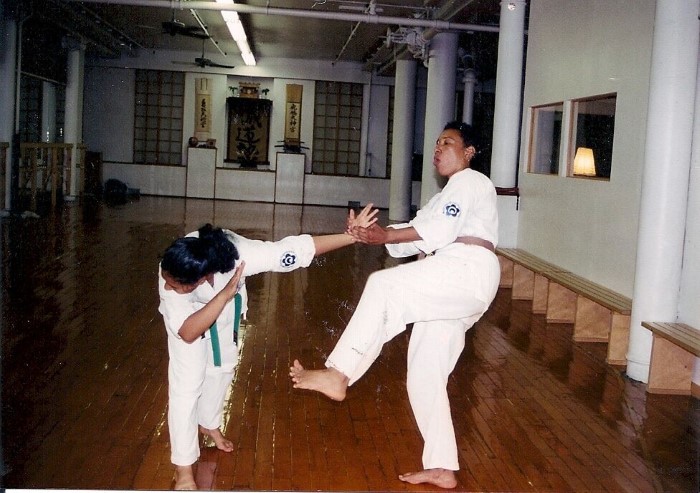
Did you have an “aha” moment?
I was training 3-4 days a week, slipping into classes at lunchtime and evenings while working in sales for a Fortune 500 company. My boss, who just couldn’t understand my newfound “passion,” would teasingly ask if I had achieved my “pink belt” yet. My friends and family were more understanding, knowing my love of sports (tennis and running, actually having completed the NYC marathon in 1979) and my dedication to practice. Oddly enough, it was never about competition, unless you consider fine-tuning your actions as self–competition.
One regular training day, I was changing into my karate uniform—by this time I was an advanced brown belt and had been training for four years. As I tied my obi (belt), I had an epiphany – I was a karateka, a practitioner of karate. I was taking this very seriously and no longer seeing karate as simply a form of recreation. Up until that time, I was training hard without thinking of the consequences or the implications. I just enjoyed it. When I was asked to try out for a black belt, I committed to polishing my technique and honing my skills to be ready for the four weeks of testing.
Achieving my first-degree black belt meant more to me than any other degree—high school, bachelor’s, or master’s. The only certificate to grace any wall in our home is my karate certificate. I knew how hard I worked physically, mentally, and emotionally to achieve it.
In a well-run dojo (karate school), the belt system not only delineates one’s progress but other responsibilities in ranking order. As a white belt, your only responsibility is yourself. The higher up you go, the more responsibility is heaped upon you. As a black belt, you demonstrate the correct technique to the lower belts, assist in class, and help during the color belt promotions. It was during these promotions that I had my “aha” moment. Nothing pleased me more, and often brought on a few tears, than seeing students come up through the ranks. I wanted to teach karate.

What is your next act?
I teach taiji (Tai Chi) at my own dojo, Staten Island Chen Taiji, as well as other locations such as Snug Harbor Cultural Center in Staten Island.
Taiji is considered an internal art, while karate is considered an external art. It was key for me to understand the difference. Like most people, I thought taiji to be an exercise for old folks. When asked what I do, I still encounter people who are quick to tell me about the groups of old people doing taiji in the park, how beautiful it is, and how serene they look. Much to my surprise, and to theirs when I explain it, Taiji is a martial art with very deep roots in philosophy, anatomy, physics, and the mind-body connection as well as having fighting applications.
Taiji, a Chinese martial art, has five major styles. I currently teach Chen style, believed to be the source from which the other four are derived. My students are mostly women who range in age from 25 to 70. I have taught in senior centers, not-for-profit organizations, at Barnard College, and at Columbia University. I currently teach group classes twice a week, renting rooms by the hour during the winter and teaching outside four months of the year. I also do workshops.
As with karate, my joy in what I do is the developmental moments in a student’s practice. I also enjoy teaching a more holistic endeavor that requires no accouterments and can be done anywhere. I love the fact that it is a very natural art, best practiced in a natural environment.
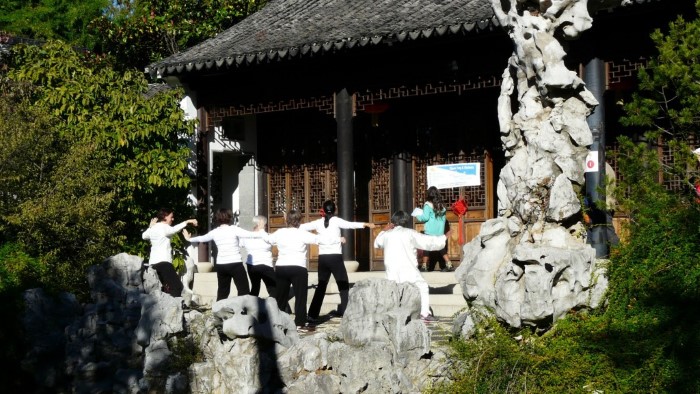
Tai Chi form demonstration at the Pan Asian Festival (I’m in all white)
How did you go from being a karate student to a taiji instructor?
When I decided I wanted to teach karate, I knew I wanted to do it my own way—be it curriculum, method, or business. I wanted to open up my own dojo (karate school).
Upon receiving approval from the grandmaster of my school, as dictated by tradition, I started planning out my school’s budget, locale, and target market. But just days before opening my dojo as an affiliate of the school, there was an incident at the school that changed my course completely. All I will say is that it was a breach of conduct. I was devastated, completely shaken.
A very dear friend of mine said, “This might be the best thing that happened to you.” He was also a karateka and had come up through the ranks with me and knew dojo drama—yes, there can be drama in a dojo, training hall gossip, just as in any joint human endeavor.
On very shaky legs, I decided to go out on my own rather than having an affiliation. I started teaching children and gradually added adults. My original dojo before the breakup was a rented room; I found a larger space and was able to expand to offer other classes that focused on self-exploration and fulfillment. I looked for teachers in other disciplines who were like-minded. I wanted to offer classes for all ages and made a good dent in most ages except for seniors.
By this time, I had been certified as a group fitness instructor and had heard of the benefits of taiji for seniors. The discipline fit in with my business mission, and I set out looking for a Taiji instructor in my area who would be willing to teach at my location. I found two, one who admitted he didn’t have the time and another who didn’t like the location in Staten Island. At this point, I decided I had to learn it to be able to teach it myself.

I started by going to a Tai Chi for Arthritis workshop, which prompted deeper taiji studies. I received certifications from the American Council on Exercise as a personal trainer (to better understand the body mechanics of taiji), from Dr. Paul Lam, and from the Center for Taiji Studies, and I attended numerous taiji workshops and classes given by the top Chen masters from China. I continue to take a weekly 2-hour private class with a master from China, learning the finer points and applications as well as weapons (taiji uses forms of broadsword, straight sword, spear, and other weapons).
Learning the form is, at first, like learning a dance. What eventually differentiates taiji from dance is its requirement to be rooted or solid on the ground while being flexible and flowing from the waist up, relaxed in all movements. This takes time! You must develop a feeling of strength in your body so you are not subject to collapsing if someone pushes you. You can sense, for example, when your arm is doing most of the work; ideally, you want your whole body involved, you don’t want to rely on an individual muscle or limb. Try pushing a heavy door about 18” above where the doorknob is located. Where do you feel strongest? Part of taiji is seeking the strongest body positioning in the moves, placing your limbs in a safe, secure, and solid position, and using your whole body to deliver the power.
Then you must develop being responsive to an opponent (called push hands practice), being able to follow (or accept) the incoming push or punch. In push hands, you are seeking your opponent’s center of gravity while attempting to keep her from finding your own center; this enables you to push her off balance. By neutralizing the opponent, that is, letting the opponent’s strength run out, you are able to easily use your own power. In this case, think about the game of hot potato. Your palms lightly follow the trajectory of the potato until you lower your body and hurl it back, usually in a pumping motion that originates in the feet. Relaxation is key to this and takes some time to develop, especially when dealing with a fast movement from an opponent.
Little did I know how that my decision to study taiji would eventually overshadow my great love of karate. Taiji is what I teach today and is my main focus. Here is a video that illustrates the type of taiji that I practice and teach.
And to learn more about taiji study, check out the trailer for the movie Chen Village.

Working with Grand Master Chen Xiao Xing on “Buddha’s Warrior Attendant Pounds the Pestle”
How did you start your own business?
My decision to go into my own business was predicated on my love of karate and the desire to have my own business. Going out on my own was thrilling, and surprising at the same time. I found it extremely difficult to set my price as my enjoyment of teaching and practice overshadowed the material aspect. This was something I never thought would be an issue. Undervaluing oneself was very easy to do.
I started reading as much as I could about starting a business. While my MBA was instrumental in understanding managing a business, I hadn’t learned about startups. I did have an idea of how to organize a dojo. I found help at the library and from S.C.O.R.E., both free resources. One of the most daunting tasks was understanding leases for space and storefronts.
Basically, thinking about going into a business requires an individual to brainstorm about everything that might be necessary, from letterhead to janitorial services, advertising to banking, utilities, and taxes. Then, you have to be realistic. What do you want from your business? What is your business plan? Is there a market for this business? What is your target market? How will you advertise? What does ‘success’ mean to you? Unfortunately, ‘build it and they will come only works if there is a need!
How did your family and friends react to your new career?
My family has been super supportive of all my endeavors, especially my husband who understands my love of martial arts completely. We have shared many Taiji-related getaways, although his interest is more in another martial art, Arnis (a Filipino martial art) and qigong.
Our son, whose interest in karate initially fueled my own, eventually stopped karate and moved on to kung fu and capoeira. Our daughter started in high school and stopped due to college. Our other son fenced in high school and college.
My children are not surprised by my newfound interest in martial arts; it doesn’t strike them as something out of the ordinary. Not meaning to brag here, but my family has always had “strong” women. My grandmother could do a pull-up at 89! No exaggeration here. My mother frequently took us out on bikes and was doing yoga in the ‘50s. My brother insisted I learn how an automobile engine worked, and how to maintain it and change a tire. Being seven years my senior, he also encouraged me to lift weights long before the term strength training was invented. These things I took for granted – and the same holds true for my children. Going into business for myself was just another event.
My friends find my passion curious as most don’t quite understand the depth of taiji. Those who take classes are beginning to understand that it is so much more than slow movement.
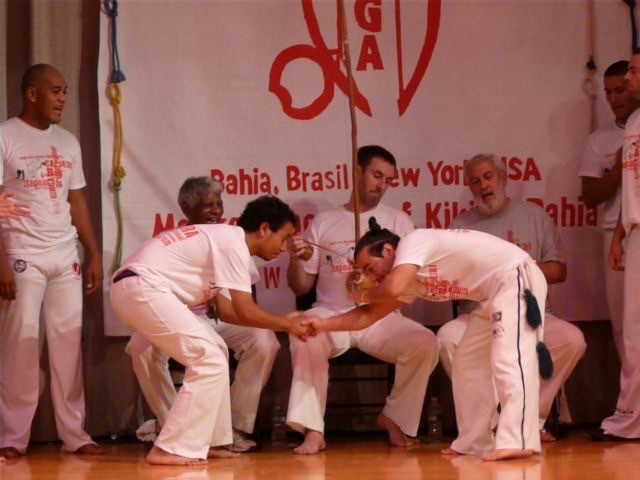
My son Dale entering the Capoira circle. The participants time their entrance to the music being played.
What challenges did you encounter as you started your own business?
One of the biggest challenges in teaching taiji outside of the local Y.M.C.A. or senior center is that taiji as a martial art has not been widely developed in this country. There is a misconception that it is something for the old folks, that it is a dance, or that it gives magical power to the practitioner. None of this is true.
I had joined the local chamber of commerce in the early days and my business ‘fit’ was like forcing a round peg into a square hole, as I am not selling widgets or real estate. My approach to networking had to be different, and more creative. I constantly have ideas about how to self-promote. Basically, for Taiji, it is a matter of public education. Few people understand that learning Taiji can be akin to going to school. One can stop after high school, go on to college, or go deeper for a postgraduate degree.
I promote my business through word of mouth and workshops. Sometimes people see me practicing outdoors for 1-2 hours daily and will ask me about it.
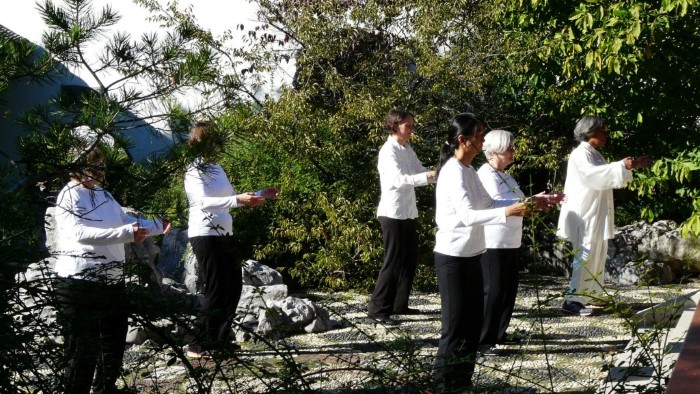
Standing meditation (I am in all white)
What have you learned about yourself through this journey?
Self-reflection is a huge part of martial arts study. I think karate gave me more insight and the courage to open my own business. I had a karate Grandmaster who was highly skilled in knowing everyone’s weakness and purposefully placed a person into a challenging situation. I had to demonstrate a series of techniques in front of the class (public performance); spar with 20- to 40-year-old men (courage); discovered my ability to teach the handicapped (patience).
One of my biggest epiphanies came, as so many did, in sparring. Knowing the physical power of an individual does not necessarily have to intimidate. I learned that 90% of all fights were lost before stepping foot into the ring due to intimidation alone. Understanding how I learned techniques and kata provided insights I can apply into my teaching of others.
For me, my midlife career change was more of finally honoring who I am, without having to be an actor in someone else’s play. I would encourage other women thinking about their next act to do their own soul searching, seeing what they innately bring to the table and the tools they have acquired along life’s path.
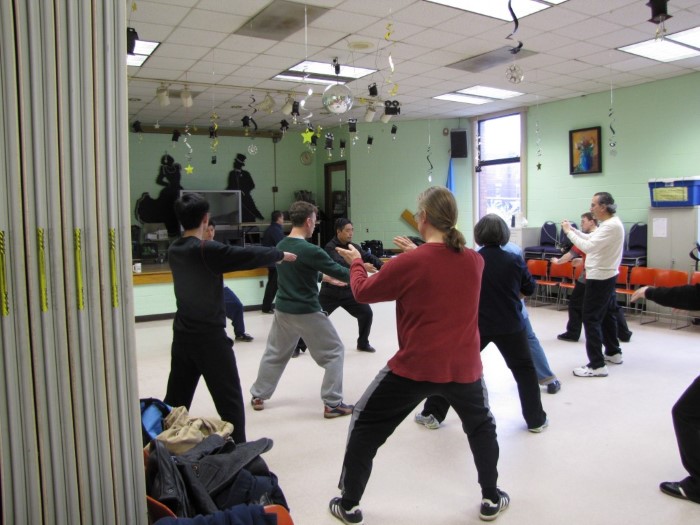
What advice do you have for women considering going into the martial arts business? What resources do you recommend?
I encourage them to be secure in their own martial arts skill and philosophy of training and to decide what success means to them. Are they more interested in turning a large profit? How will this impact the integrity of their art? Maybe they will find out that leasing a space, while impressive, means maintaining a large student body and demanding less of their students.
The US dojos are too quick to give out black belts. A martial arts equipment supplier once told me there were more black belts in the state of New Jersey than in all Japan. There are places that will grant a black belt in a year and a half if the student will pay upfront for the “accelerated” program. That’s a question we all have to ask. Value our art or value the income.
Embarking on a business is a journey. One of the first books I found to be helpful was Small Time Operator: How to Start Your Own Business, Keep Your Books, Pay Your Taxes, and Stay Out of Trouble, by Bernard B. Kamoroff C.P.A. SCORE’s volunteers can help you understand the lay of the land for startups in your area and provide you with a personal prod. These are basic for any business.
For martial arts, it helps to know a bit about exercise science and group fitness. I found the American Council on Exercise (ACE) certifications very helpful. Of course, certification in CPR and AED (defibrillation) doesn’t hurt and is required as part of the ACE certification (check out the American Red Cross and the American Heart Association for course locations).
A word about certifications for taiji: This is a sticky point, as providing certificates in so many disciplines in this country has become big business, and taiji is no exception. I have seen certifications given after a weekend of study or up to two years. Mainland China has now jumped on the bandwagon, and certifications are available from various schools and universities there. But even this is contentious, as taiji has been changed to accommodate tourists, becoming more acrobatic rather than a martial art.
So if you are interested in taiji for specific health issues, Dr. Paul Lam’s curriculum is a good one. Dr. Lam developed arthritis while he was still in medical school. He remembered his mother practicing taiji and tried it; it helped tremendously. He developed Tai Chi for Arthritis by taking a subset of the taiji poses that are easy for someone with arthritis to perform; his course also explains what causes arthritis and what to be mindful of when teaching people with arthritis. He has compartmentalized each taiji benefit into an individual course to help a particular ail: arthritis, lower back pain, diabetes, general health, etc. You can get certified in any of these. His curriculum is also recognized by the United States Center for Disease Control.
If you’d like to go deeper into taiji roots, as I did, be mindful of teachers’ backgrounds. (tournament skills may not transpose to teaching skills). I’d recommend the Center For Taiji Studies for a deeper study of taiji and the traditional curriculum that surrounds it.
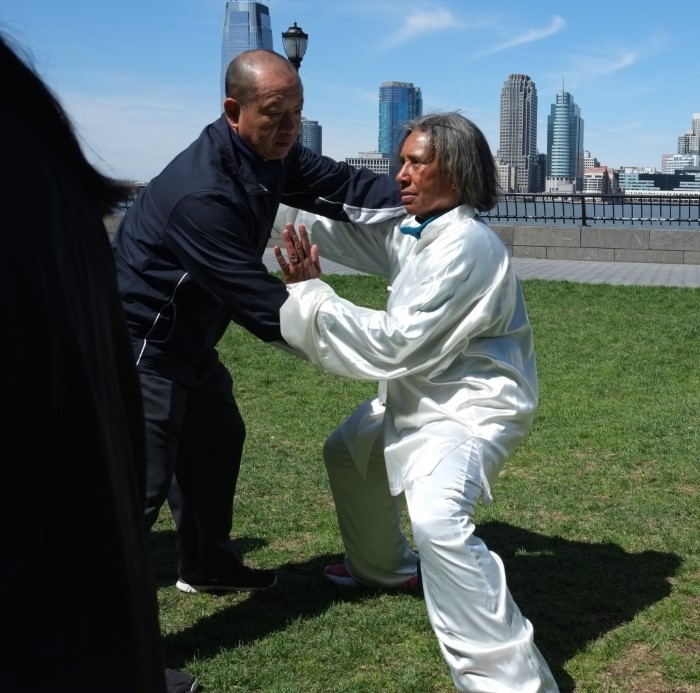
Fine-tuning with my teacher, Master Yu, Guo Shun
Dr. Yang Yang, Ph.D. in kinesiology and a taiji master, offers a solid certification, which incorporates the traditional taiji curriculum. Be aware that certification means at best that one understands and can demonstrate taiji principles, at worst that you can only remember a form.
To explain, the solo practice of taiji, which is what people are most familiar with, has flowing movements. From beginning to end, this is called a form, similar to kata in karate. Each form is comprised of postures. Thus, the form known as Lao Jia Yi Lu in Chen Taijiquan is made up of 75 postures, with names such as Single Whip, Lazily Tying The Coat, and Golden Rooster Stands On One Foot. In order to be competent in Taiji, one must uphold taiji principles throughout the form in all postures.
Practice teaching in a variety of settings. Volunteering is always a good way to start. I shadowed teachers for a number of months before I was on my own.
Finally, know your goals in teaching and self-correct as needed. I have expectations of my students. My expectations must be flexible enough to accommodate those students who come to class with physical challenges, for instance, scoliosis. I have to correct my expectations to accommodate that student, to have them reach what might be a stretch for them, and yet not to discourage them by asking too much. It is a fine line. That’s why I prefer smaller classes. I can give more attention to individuals.
Contact Natasha Spearman-Isip at 347-813-1802 or info@sichentaiji.com
Staten Island Chen Taiji

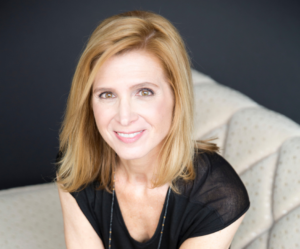
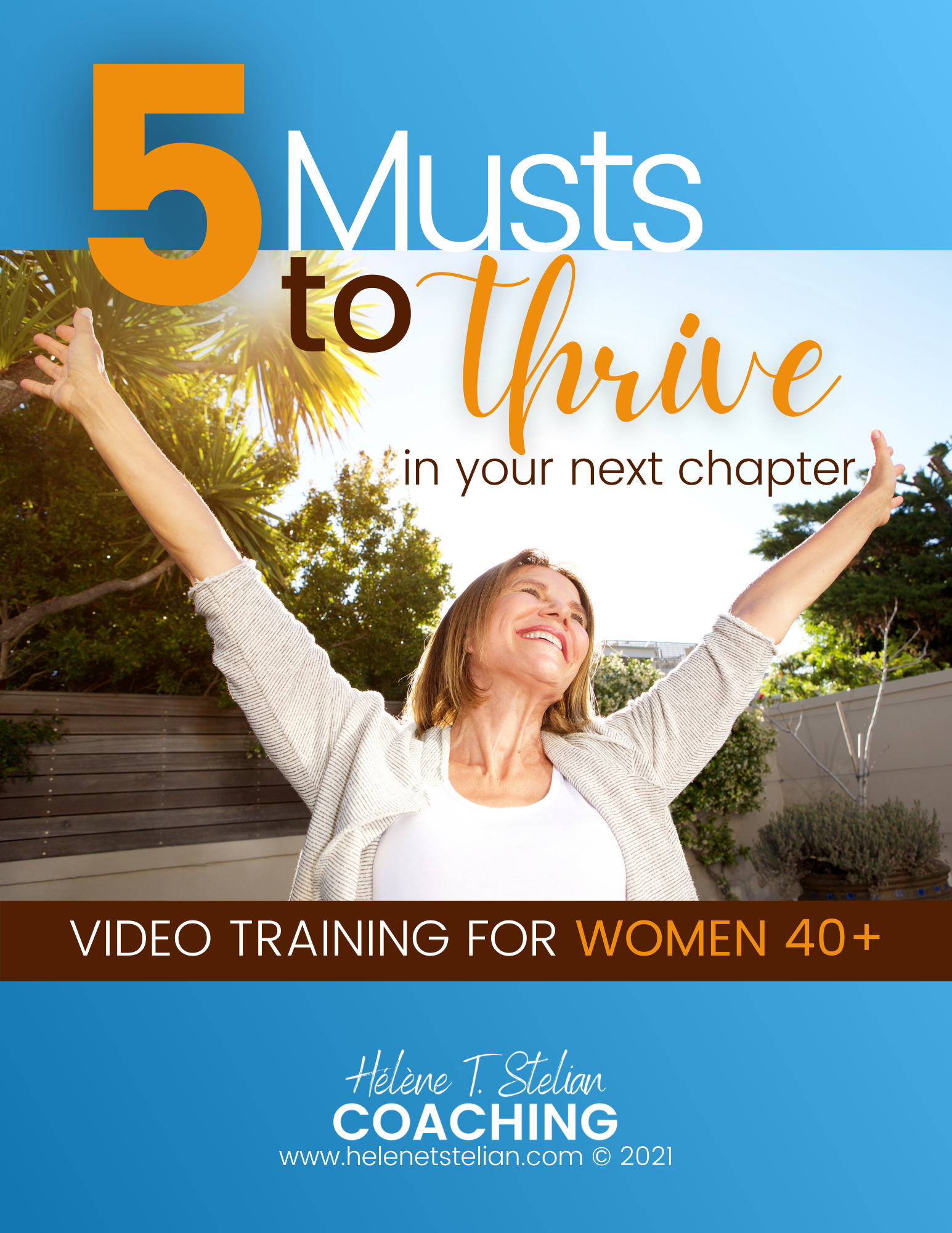



Tai chi is a magical thing with so many benefits! I can see its appeal and especially as we age.
Carol, I couldn’t agree with you more. I’d love to see more people practicing in large groups in parks for a wonderful start to their day!
Wow! Thank you for introducing Natasha to us, what a journey. It has me thinking, I studied tae kwon do and arnis years ago – with my boys. I loved everything about both disciplines. Now at 54 I find myself thinking of going back to a martial art. Wonderful interview, I feel like I have had the privilege of sitting down and having tea with both of you.
I’m sure you won’t regret going back to the martial arts, Terri. When I stepped into the larger dojo and saw women well into their sixties practicing, it gave me a green light I really didn’t know I needed. We never stop growing, only limit ourselves with perceptions. Good luck with you martial arts search, and if you have any taiji questions, I’d be glad to help!
Best line: “What other things do we dance around in life rather than taking the chance of getting hit?” Thank you, Natasha for sharing your story and thanks, Hélène, for seeking out these fabulous women! I look forward to these interviews!
Thanks for taking the time to read, Corie, and great thanks to Helene for the opportunity to reflect!
A great inspiration of exercise alternatives! I was in a 6 month study of women cancer survivors over the age of 55. I was put into the Thai Chi group. The instructor had developed a program for Parkinson patients and adapted it to our study. It really helped my balance which surprised me!
Haralee, taiji offers so much! I’m glad you found one of the surprises of practice.I’m hoping you’ll continue in your taiji journey to find other nuggets of benefits! Good luck!
Great story. Experts in multiple arts are hard enough to find; those who can teach well, and run a good business too, are very special indeed.
Inspiring history!
The evidence that martial arts are for everyone despite the age!
Thank you!
Cheers
Jason